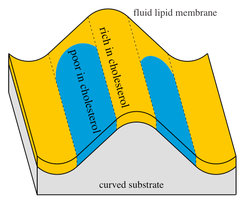Membranes with Stripes
Stable patterns of membrane domains arise from the interplay of curvature and line tension.
Biological membranes contain a multitude of lipid molecules, which tend to form clusters and domains. In general, it is impossible to control the size of these domains since they readily coalesce and grow into larger and larger structures. Scientists of the Max Planck Institute of Colloids and Interfaces have shown theoretically that the interplay of curvature and line tension leads to the formation of stable patterns of membrane domains. This explains experimentally observed patterns in membranes adhering to corrugated substrates and may help to understand domain patterns in biological membranes. (Physical Review Letters, 7 March 2008).

Biological membranes are the “skin” of cells. On the one hand, they separate the interior of the cell from its environment. On the other hand, they allow a vital exchange of ions and molecules. In addition, they are involved in central biological processes such as photosynthesis and recognition. Biological membranes are rather flexible and can attain a multitude of different shapes. Their elastic properties depend on the different lipids and proteins that form the membranes.
Although the lipid molecules diffuse quickly along the fluid membranes, they are not homogeneously distributed. Instead, they tend to form domains that are either rich or poor in cholesterol. The cholesterol-rich domains are stiffer than the cholesterol-poor domains, which has direct implications on membrane curvature. Vice versa, these curvatures affect the domain formation. Curvature and domain formation thus depend on each other.
The question now is: Can curvatures that are imposed on the membrane, e.g. by a corrugated substrate, cause stable domain patterns? Bartosz Rózycki, participating scientist, says yes: If the substrate has a geometrically structured surface with periodic undulations, the stiffer cholesterolrich domains tend to avoid the curved parts of the membrane. The domain patterns are stable as long as the curvature of the substrate surface exceeds a threshold value that depends on the line tension of the domain boundaries. Below this threshold, a single cholesterol-rich domain forms which covers many ridges and valleys of the substrate.
The theoretical calculations explain patterns that have already been observed in experiments. They might also help to understand why biological membranes seem to exhibit only small domains rich in cholesterol, whereas large domains with a size of many micrometers are observed in biomimetic model membranes. In contrast to artificial membranes, biological membranes are attached to the cytoskeleton of the cell, i.e. to a network of filaments that actively curves the membranes. Besides other active cell processes, these curvatures could stabilize membrane patterns with small cholesterol-rich domains.
Original Publication
Stable Patterns of Membrane Domains at Corrugated Substrates
Bartosz Rózycki, Thomas R. Weikl, Reinhard Lipowsky
Phys. Rev. Lett. 100, 098103 (2008)












